1857 Officer, Madras Horse Artillery
£12.50
1857 Officer, Madras Horse Artillery (scroll down for a more detailed Description)
Published 1966 by © Hugh Evelyn Limited; drawn by Colonel Philip Henry Smitherman (1910-1982), Royal Corps of Signals
Size: c. 24.5 x 37.5cm [9 ½ ″ x 14 ½ ″] (may vary slightly from printers’ cut 50 years ago)
Printed on on medium cardstock weighing 144 g/sm2 faced in light greyish blue (RGB c. d5dede)
Print is STANDARD size – shipping is the same for 1 to 10 prints (based on largest print size in your order) – see Shipping & Returns
In stock
Description
The Madras Presidency was the first to raise artillery, its oldest foot company dating back to 1748. ‘A’ Troop, Horse Artillery, was not raised until 1805, and by the Mutiny the Madras Horse Artillery mustered four British and two Indian troops, both of which remained loyal. Its history cannot compare with that of the Bengal Horse Artillery for action, nevertheless it bore several battle honours bravely won. ‘A’ Troop existed as J (Sidi Rezegh) Battery Royal Horse Artillery, a Close Support Battery of 3rd Regiment Royal Horse Artillery. They were based in Caen Barracks in Hohne, Germany ‘C’ Troop was P Battery (The Dragon Troop) a battery of 5th Regiment, Royal Artillery in the Royal Regiment of Artillery. It currently serves in the Surveillance and Target Acquisition role and is equipped with weapon platform locating equipment, which include radar and sound ranging systems. The title ‘Dragon Troop’ commemorates the battle honour ‘China’ borne by ‘C’ Troop. The uniform bears a general resemblance to that of the R.H.A. The cross-belt bears the battle honours of the regiment. The centre buttons on the jacket are purely ornamental and are not fastened. In this jacket the loops, except for the top one, are merely left undone, the jacket being fastened by hooks and eyes. In the other two jackets each loop is passed through the loop below it, the last loop being sewn down. This arrangement persisted in the mess dress of some of the regiments of the Indian Army up to 1939. Sources: Helmet and jacket and various photographs in the R.A. Museum, Woolwich, London.
Additional information
| Weight | 0.0125 kg |
|---|---|
| Dimensions | 24 × 37 cm |





